2018 9th IFIP International Conference on New Technologies Mobility and Security (NTMS), IEEE, 04/2018. DOI
Abstract
The Internet of Things (IoT) is an environment of interconnected entities, that are identifiable, usable and controllable via the Internet. Trust is necessary in a system such as IoT as the entities involved should know the effect of interacting with other entities. Moreover, the entities must also be able to trust a system to reliably use it. An IoT system is composed of different entities from different vendors, each of them with a different purpose and a different lifecycle. So considering trust in the whole IoT system lifecycle is useful and necessary to guarantee a good service for the whole system. The heterogeneity and dynamicity of this field make it difficult to ensure trust in IoT. We propose a trust by design framework for including trust in the development of an IoT entity considering all the phases of the life-cycle. It is composed of the K-Model and transversal activities.
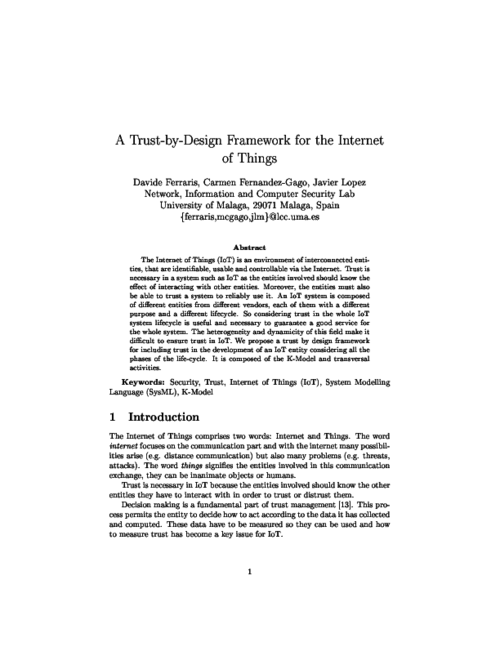
26th International Conference on Advanced Information Systems Engineering (CAiSE 2014), M. Jarke, et al. Eds., LCNS 8484, Springer, pp. 136-149, 06/2014. DOI
Abstract
Cloud sourcing consists of outsourcing data, services and infrastructure to cloud providers. Even when this outsourcing model brings advantages to cloud customers, new threats also arise as sensitive data and critical IT services are beyond customers' control. When an organization considers moving to the cloud, IT decision makers must select a cloud provider and must decide which parts of the organization will be outsourced and to which extent. This paper proposes a methodology that allows decision makers to evaluate their trust in cloud providers. The methodology provides a systematic way to elicit knowledge about cloud providers, quantify their trust factors and aggregate them into trust values that can assist the decision-making process. The trust model that we propose is based on trust intervals, which allow capturing uncertainty during the evaluation, and we define an operator for aggregating these trust intervals. The methodology is applied to an eHealth scenario.
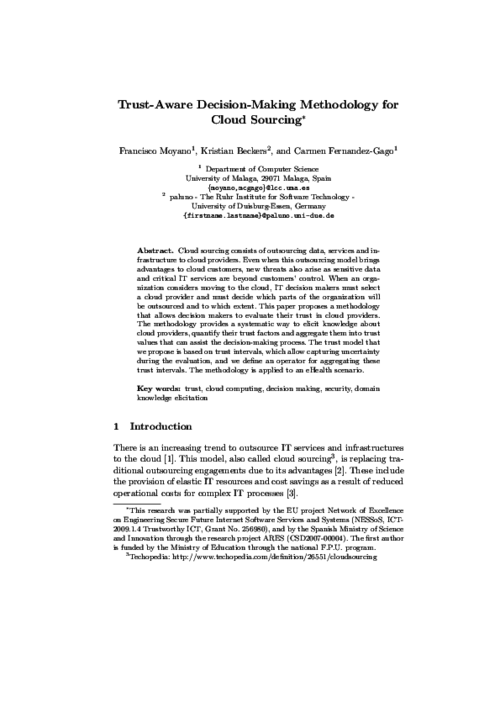
3rd International Workshop on Information Systems Security Engineering (WISSE 2013), X. Franch, and P. Soffer Eds., LNBIP 148, Springer-Verlag, pp. 490-501, Jun 2013. DOI
Abstract
Security must be a primary concern when engineering Future Internet (FI) systems and applications. In order to achieve secure solutions, we need to capture security requirements early in the Software Development Life Cycle (SDLC). Whereas the security community has traditionally focused on providing tools and mechanisms to capture and express hard security requirements (e.g. confidentiality), little attention has been paid to other important requirements such as trust and reputation. We argue that these soft security requirements can leverage security in open, distributed, heterogeneous systems and applications and that they must be included in an early phase as part of the development process. In this paper we propose a UML extension for specifying trust and reputation requirements, and we apply it to an eHealth case study.
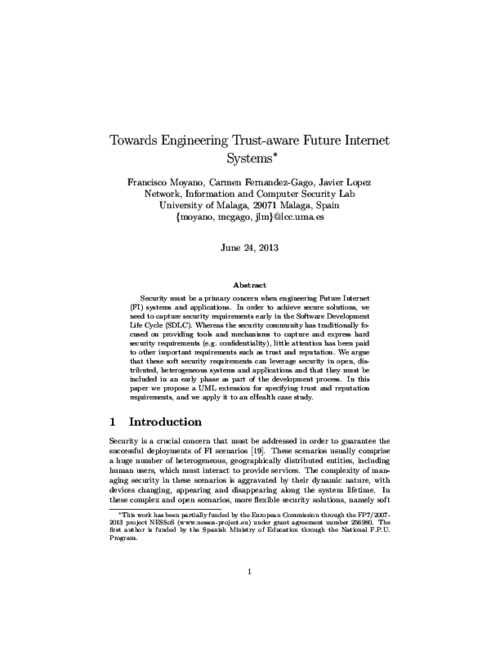
7th IFIP WG 11.11 International Conference on Trust Management (IFIPTM 2013), C. Fernandez-Gago, I. Agudo, F. Martinelli, and S. Pearson Eds., AICT 401, Springer, pp. 255-262, Jun 2013. DOI
Abstract
The Future Internet (FI) comprises scenarios where many heterogeneous and dynamic entities must interact to provide services (e.g., sensors, mobile devices and information systems in smart city scenarios). The dynamic conditions under which FI applications must execute call for self-adaptive software to cope with unforeseeable changes in the application environment. Software engineering currently provides frameworks to develop reasoning engines that automatically take reconfiguration decisions and that support the runtime adaptation of distributed, heterogeneous applications. However, these frameworks have very limited support to address security concerns of these application, hindering their usage for FI scenarios. We address this challenge by enhancing self-adaptive systems with the concepts of trust and reputation. Trust will improve decision-making processes under risk and uncertainty, in turn improving security of self-adaptive FI applications. This paper presents an approach that includes a trust and reputation framework into a platform for adaptive, distributed component-based systems, thus providing software components with new abilities to include trust in their reasoning process.
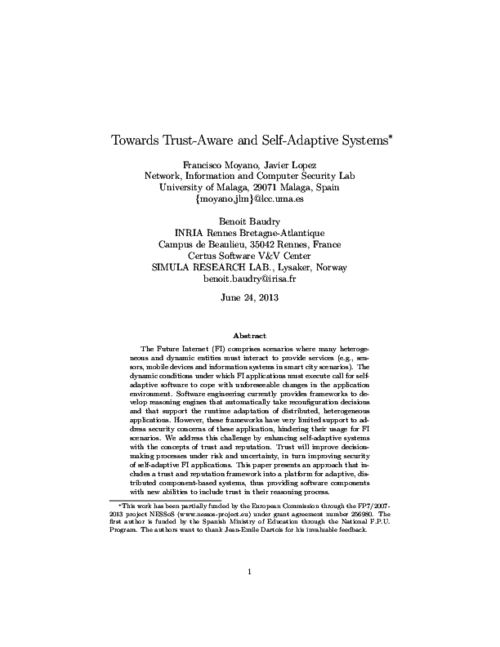
Doctoral Symposium of the International Symposium on Engineering Secure Software and Systems (ESSoS-DS 2013), M. Heisel, and E. Marchetti Eds., CEUR-WS 965, CEUR-WS, pp. 7-12, 2013.
Abstract
The Future Internet is posing new security challenges as their scenarios are bringing together a huge amount of stakeholders and devices that must interact under unforeseeable conditions. In addition, in these scenarios we cannot expect entities to know each other beforehand, and therefore, they must be involved in risky and uncertain collaborations. In order to minimize threats and security breaches, it is required that a well-informed decision-making process is in place, and it is here where trust and reputation can play a crucial role. Unfortunately, services and applications developers are often unarmed to address trust and reputation requirements in these scenarios. To overcome this limitation, we propose a trust and reputation framework that allows developers to create trust- and reputation-aware applications.
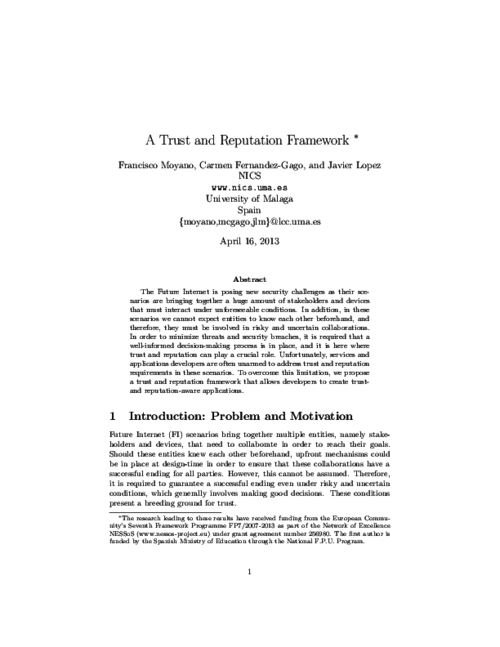
IEICE Trans. on Information and Systems, vol. E94-D, IEICE, pp. 243-254, Feb 2011. DOI
Abstract
The systematic processes exactly define the development cycle and help the development team follow the same development strategies and techniques, thus allowing a continuous improvement in the quality of the developed products. Likewise, it is important that the development process used integrates security aspects from the first stages at the same level as other functional and non-functional requirements. Grid systems allow us to build very complex information systems with different and remarkable features (interoperability between multiple security domains, cross-domain authentication and authorization, dynamic, heterogeneous and limited mobile devices, etc). With the development of wireless technology and mobile devices, the Grid becomes the perfect candidate for letting mobile users make complex works that add new computational capacity to the Grid. A methodology of development for secure mobile Grid systems is being defined. One of the activities of this methodology is the requirements analysis which is based in reusable use cases. In this paper, we will present a UML-extension for security use cases and Grid use case which capture the behaviour of this kind of systems. A detailed description of all these new use cases defined in the UML extension is necessary, describing the stereotypes, tagged values, constraints and graphical notation. We show an example of how to apply and use this extension for building the diagram of use cases and incorporating common security aspects for this kind of systems. Also, we will see how the diagrams built can be reused in the construction of others diagrams saving time and effort in this task.
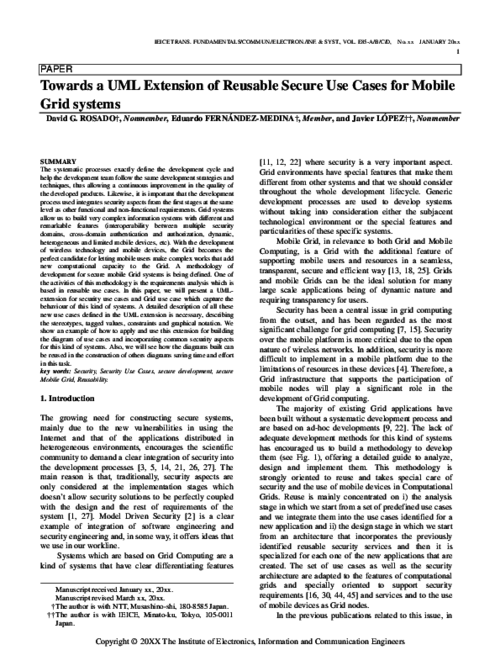
6th International Conference on Information Security (ISC’03), LNCS 2851, Springer-Verlag, pp. 381-395, October, 2003.
Abstract
A challenging task in security engineering concerns the specification and integration of security with other requirements at the top level of requirements engineering. Empirical studies show that it is commonly at the business process level that customers and end users are able to express their security needs. In addition, systems are often developed by automating existing manual business processes. Since many security notions belongs conceptually to the world of business processes, it is natural to try to capture and express them in the context of business models in which moreover customers and end users feel most comfortable. In this paper, based on experience drawn from an ongoing work within the CASENET project \cite{CASENET}, we propose a UML-based business process-driven framework for the development of security-critical systems.
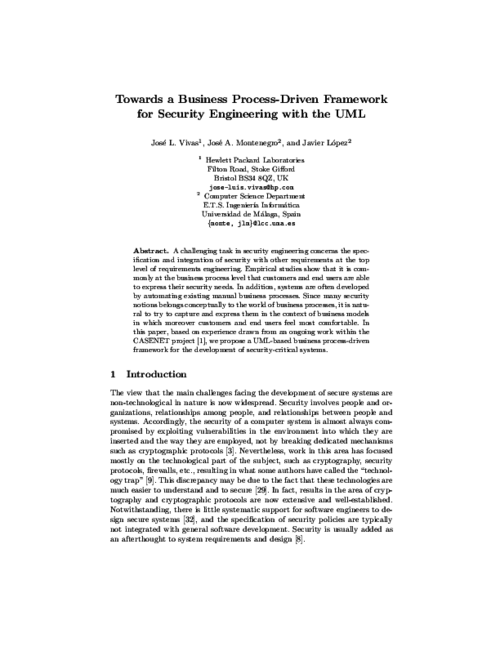
 ]
]